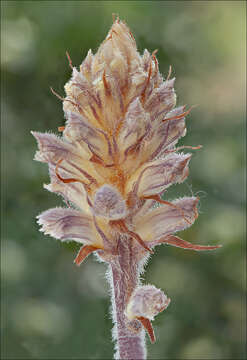Orobanche-minor_2

Description:
Orobanche minor Sm., syn.: Orobanche langei Huter, Porta & Rigo, Orobanche major f. hypochoeridis Beck, Orobanche maritima Pugsley, Orobanche salisii Req. ex Coss. Orobanche crithmi Bertol., Orobanche grisebachii Reut., Orobanche salisii Reut., Orobanche pumila Rchb., Orobanche pyrrha Rchb., Orobanche barbataand about 20 other names.Family: Orobanchaceae Vent.EN: Lesser Broomrape, Common Broomrape, DE: Kleine Sommerwurz, Klee-Wrger, KleeteufelSlo.: mali pojalnik Dat.: May 5. 2023Lat.: 44.51458 Long.: 14.31025Code: Bot_1523/2023_DSC2872Habitat: sandy sea shore, among grasses and other tall herbs; locally flat terrain; open, sunny, dry place; precipitations ~ 900 mm/year, average temperature 12-14 deg C, elevations 6 m (20 feet), Sub-Mediterranean phytogeographical region. Substratum: sandy soil.Place: Adriatic Sea region, island Susak, sea shore about 200 m north of the harbor, Kvarner archipelago, Rijeka region, Croatia. Comments (pertain to pictures in Flicker album Orobanche minor): Orobanche minor was a few hundred years ago a Mediterranean species. However, it was spread by men by agricultural trade almost all over the world. Today it can be found in the almost whole Europe, in Africa, Asia, America and New Zeeland. Although widely distributed, it is quite a rare plant. The possible exception is monoculture agricultural land where its hosts grow e.g. clover fields, where it can appear massively and can completely destroy the harvest.This find is from island Susak in Adriatic Sea having a unique geology. The island is the only one among hundreds of islands along east shore of Adriatic Sea, consisting 100% from sand. Orobanche species are very variable. Proper determination is not always an easy task. In addition, their appearance depends on their actual host. This heavily pertains to Orobanche minor since its hosts are many: several species of Trifolium, other Fabaceae as well as Asteraceae. However, the combination of traits of the plants shown here speak in favor of Orobanche minor: small to medium size plants with densely glandular pubescence, small flowers (compared to other similar species), tubular, only slightly inflated at the end, corolla with conspicuous violet veins near the upper lip, almost glabrous style with dark purple-brown two-lobed stigma, entire calix segments and long bracts.Ref.:(1) A. Martini et all., Mala Flora Slovenije (Flora of Slovenia - Key) (in Slovenian), Tehnina Zaloba Slovenije (2007), p 578. (2) T. Nikoli, Flora Croatica, Vaskularna flora Republike Hrvatske, Vol. 3. Alfa d.d.. Zagreb (2020) p 235,(3) M. Blamey, C. Grey-Wilson, Wild Flowers of the Mediterranean, A & C Black, London (2005), p 417.(4) C.A.J. Kreutz, Orobanche, The European broomrape species, Vol.1., Central and Northern Europe, Stichting Natuurpublicaties Limburg, Maastrich (1995), p 120.
Included On The Following Pages:
- Life (creatures)
- Cellular (cellular organisms)
- Eukaryota (eukaryotes)
- Archaeplastida (plants)
- Chloroplastida (green plants)
- Streptophyta
- Embryophytes
- Tracheophyta (ferns)
- Spermatophytes (seed plants)
- Angiosperms (Dicotyledons)
- Eudicots
- Superasterids
- Asterids
- Lamiales ("An Order: Mints, Vervains, Snapdragons, Etc.")
- Orobanchaceae (broomrape family)
- Orobanche (broomrape)
- Orobanche minor (clover broomrape)
This image is not featured in any collections.
Source Information
- license
- cc-by-nc-sa
- copyright
- Amadej Trnkoczy
- photographer
- Amadej Trnkoczy
- original
- original media file
- visit source
- partner site
- Flickr Group
- ID


